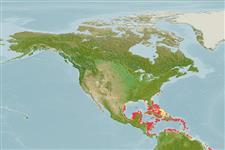Common names from other countries
Classification / Names / Names
Common names | Synonyms | Catalog of Fishes (gen., sp.) | ITIS | CoL | WoRMS
Environment: milieu / climate zone / depth range / distribution range
Ecology
Reef-associated; brackish; depth range 0 - 18 m (Ref. 108813). Tropical
Western Central Atlantic.
Length at first maturity / Size / Weight / Age
Maturity: Lm ? range ? - ? cm
Grows in either in vase-, tube- or cup-shape, broadening upward from the base up to 50 cm in height. Fan-shape rare; may be globular or tubular in small specimens. Surface smooth or with conules or soft spines up to 6 mm in height ; coarsely porous. Color varies from pale purplish pink to light bluish to grayish green or gray. Compressible. Small round oscules present inside the vase or cup. A fringe of soft spines usually connected by a transparent membrane is present at the apical opening (Ref. 85482).
Life cycle and mating behavior
Maturity | Reproduction | Spawning | Eggs | Fecundity | Larvae
Members of the class Demospongiae are hermaphroditic. Life cycle: The zygote develops into parenchymella larva (free-swimming) before settling down on a substrate where it grows into a young sponge.
Engel, S. and J.R. Pawlik. 2005. (Ref. 837)
IUCN Red List Status (Ref. 130435: Version 2024-1)
CITES status (Ref. 108899)
Not Evaluated
Not Evaluated
Human uses
| FishSource |
Tools
More information
Age/SizeGrowthLength-weightLength-lengthMorphologyLarvaeAbundance
Internet sources
Estimates based on models
Preferred temperature
(Ref.
115969): 25.5 - 28.2, mean 27.3 (based on 446 cells).
Price category
Unknown.
